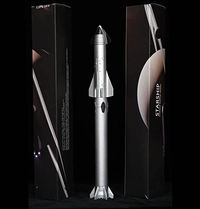SpaceX test-fires Super Heavy Starship booster ahead of 5th flight (video)
The launch could take place in just a couple weeks.
Super Heavy is breathing fire once again.
SpaceX ignited the engines on its Super Heavy booster yesterday (July 15), ahead of Starship's next integrated flight test (IFT), expected in the next few weeks. IFT-5 will be fifth launch of Starship's fully-stacked vehicle, and its most ambitious to date.
The spacecraft has been contracted by NASA as the lunar lander for its Artemis 3 mission, and has also been touted by SpaceX CEO Elon Musk as eventually being capable of flying humans to Mars.
The 233 foot (71 meter) booster was rolled to the launchapd at SpaceX's test site on July 9, ahead of yeaterday's full-duration "static test fire," at the company's Starbase facility, in Texas. With Super Heavy secured to launchpad, the rocket's 33 Raptor engines fire at full thrust for about 20 seconds in video captured and shared by SpaceX in a post on X.
Full duration static fire of Flight 5 Super Heavy booster pic.twitter.com/8rF9KUdMUDJuly 15, 2024

Each of Starship's four test flights has gone farther and accomplished more than its predecessor, with the rocket's the most recent launch in June being hailed as a complete success. That launch saw Starship and its Super Heavy booster both return, as planned, for controlled ocean splashdowns. Now, hoping to build on that success, SpaceX will attempt to reach even further on Starship's fifth flight.
Related: SpaceX rolls Starship Super Heavy booster to launch pad ahead of 5th test flight (video, photos)
Starship is designed to as a completely reusable system. Like the first-stage of SpaceX's Falcon 9 booster, Super Heavy is designed with grid fins to help control its reentry through the atmosphere, but unlike the current workhorse of SpaceX's fleet, when Super Heavy returns to land, the plan is for it to fly straight back to the pad where it launched.
Get the Space.com Newsletter
Breaking space news, the latest updates on rocket launches, skywatching events and more!
Starship Die Cast Rocket Model Now $69.99 on Amazon.
If you can't see SpaceX's Starship in person, you can score a model of your own. Standing at 13.77 inches (35 cm), this is a 1:375 ratio of SpaceX's Starship as a desktop model. The materials here are alloy steel and it weighs just 225g.
Note: Stock is low so you'll have to act quickly to get this.
The Starship launch tower features two massive "chopstick" arms that are designed to catch Super Heavy by its grid fins, as the booster arrests its momentum to a momentary standstill in midair to sucumb to the chopsticks' tender embrace. This way, in the efforts of rapid refurbishment, the booster is already where it needs to be in order to launch again.
During its fourth flight, though Super Heavy's landing burn over the ocean was nowhere near its launchpad in Starbase, Texas, SpaceX closed the launch tower's chopstick arms in conjunction with the booster's water landing, seemingly to test the system's timing and capabilities. Now, they're going to try it for real. Following the success of IFT-4, Musk wrote in a post on X, "aiming to try this in late July!" in response to a video featuring an animated Super Heavy booster catch.
As for when the next Starship launch will take place, on July 5, Musk said "four weeks," in a post on X. That timeline would put the launch around Aug. 2, however the rocket billionaire's estimates are often optimistically hopefull. So, at the earliest, we may see Starship IFT-5 liftoff around the beginning of August.
Join our Space Forums to keep talking space on the latest missions, night sky and more! And if you have a news tip, correction or comment, let us know at: community@space.com.

Josh Dinner is Space.com's Content Manager. He is a writer and photographer with a passion for science and space exploration, and has been working the space beat since 2016. Josh has covered the evolution of NASA's commercial spaceflight partnerships, from early Dragon and Cygnus cargo missions to the ongoing development and launches of crewed missions from the Space Coast, as well as NASA science missions and more. He also enjoys building 1:144 scale models of rockets and human-flown spacecraft. Find some of Josh's launch photography on Instagram and his website, and follow him on Twitter, where he mostly posts in haiku.
